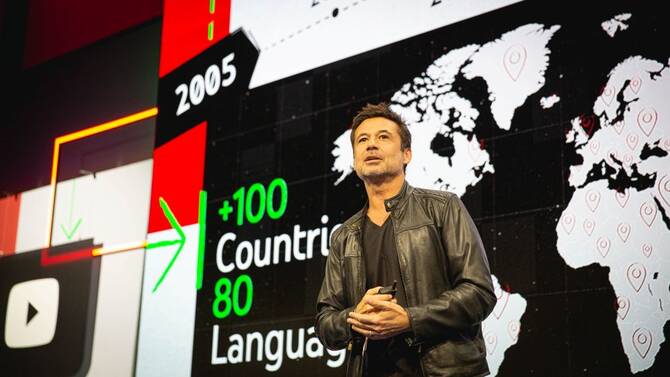
- Pedro Pina took journalists back in time by showing videos of early meetings between the YouTube co-founders.
ZURICH/RIYADH: YouTube has set its sights on Saudi Arabia, seeking to shift video consumption from smartphones to TV and capitalizing on the kingdom’s attachment to the platform.
As it celebrates its 20th anniversary, the platform envisions a new era for the region, positioning YouTubers like Noor Stars as the next Hollywood stars. YouTube is also exploring the power of artificial intelligence, including dubbing and other innovative features, to engage users on the big screen.
Pedro Pina, YouTube’s vice president of Europe, Middle East and Africa, told Arab News: “Whether it’s Egypt or Saudi Arabia, we want to be the cultural zeitgeist; we want to be the future of television.
“That will happen when these countries gain momentum in terms of connectivity.”
According to a study published based on YouTube’s internal data, the platform reaches more than 12 million people in Saudi Arabia, more than 2.5 million in the UAE and 600,000 people in Qatar over the age of 18 through connected TV.
Saudi Arabia has developed a strong attachment to YouTube, with 95.8 percent of the population using the platform. As YouTube seeks to move viewing from smartphones to TVs, it aims to improve the way Saudi audiences consume content.
In the US, TV has become the primary device for watching YouTube, while viewers in the Middle East are switching from smartphones to TVs.
During a two-day press conference to mark YouTube’s anniversary in Zurich, the platform’s executives gathered to discuss its growth since its inception in 2005, as well as future features and vision for the region.
Among the executives who spoke about YouTube’s evolution and progress were Pina; Amjad Hanif, vice president of product management for creators at YouTube; Roya Zeitoun, head of culture and trends at YouTube in Europe, the Middle East and Africa; and Jeff van der Meer, vice president of engineering.
Pina took journalists back in time by showing a video of the YouTube co-founders’ first meetings, where they discuss the future of the platform.
He stressed that there had been “a lot of conversations” between the co-founders about where the site would be located… and what they were going to do with the ability to upload videos.
YouTube has four key areas of focus for its future: remaining the epicenter of culture, turning content creators into Hollywood startups, turning YouTube into the new television, and deploying artificial intelligence to improve the experience for viewers and creators.
“Creators continue to be new startups. Noor Stars is one of the creators who is incredibly successful in the region,” Pina said, adding that she represents one of the success stories in YouTube’s mission: “To give everyone a voice and show them the world. That has been our goal from the beginning.”
Pina stressed that YouTube is very popular with viewers from all over the Middle East, citing the region’s diverse cultures and realities.
When asked what new features to expect in the region, Pina said: “The solutions will look and feel different in each country (in the Middle East) as they are at different levels of development.
“For example, connected TV penetration rates vary across countries, and so the future of TV viewing for content creators will also differ from region to region.”
Among the topics the executives discussed was podcasting. As podcasting becomes increasingly popular, Pina highlighted YouTube’s recently released stats: More than 1 billion people engage with podcast content on YouTube each month, and those viewers watch more than 400 million hours of podcasts each month on their TVs.
The rise of podcasts as a mainstream media format is not unexpected. The most-watched podcast episode on YouTube right now is from Saudi Arabia’s Thmanyah, a sister publication of SRMG-run Arab News, with 140 million views.
Another topic of discussion was the YouTube Partner Program, which allows creators to earn sustainable income and build a business while pursuing their passions through content creation.
According to internal YouTube data, in Saudi Arabia, the number of YouTube channels earning seven figures or more in Saudi riyals has grown by 40 percent year-on-year. And in the UAE, the number of YouTube channels earning seven figures or more in Saudi riyals has grown by 15 percent year-on-year.
Hanif said there are currently 3 million YouTube users in the partner program, and more than half a million of them started their channels more than a decade ago.
Hanif added: “It speaks to the sustainability and thoughtfulness we put into the programme to ensure they have the opportunity to build a business this year, and YPP gives them the opportunity to continue to build and grow that business.”
The first video on YouTube was uploaded on April 23, 2005, by Jawed Karim, one of the platform’s three co-founders. The video was titled “Me at the Zoo.” Since then, YouTube has grown exponentially, and as of April 2025, more than 20 billion videos have been uploaded.